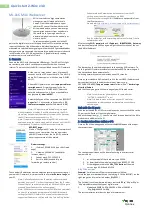
References
Medialon MAS Pro Dante User Manual
p 61 of 88
M516-2 | 2020-05-19
7.1.3
Audio File Format
WAV file format: 16 bit or 24 bit /48KHz
7.2
Dante
Dante is a combination of software, hardware, and network protocols that deliver uncompressed,
multi-channel, low-latency digital audio over a standard Ethernet network. Developed in 2006 by a
Sydney-based company named Audinate, Dante builds and improves on previous audio over
Ethernet technologies, such as CobraNet® and EtherSound. Like most other audio over Ethernet
technologies, Dante is primarily for professional, commercial applications. Most often, it is used in
applications where a large number of audio channels must be transmitted over relatively long
distances or to multiple locations.
Dante provides several advantages over traditional analog audio distribution. Audio transmitted
over analog cables can be adversely affected by signal degradation due to electromagnetic
interference, high- frequency attenuation, and voltage drop over long cable runs. Thanks to digital
multiplexing, the cabling requirements for digital audio distribution are almost always reduced
when compared to analog audio. Dante also provides specific advantages over first-generation
audio over Ethernet technologies, such as CobraNet and EtherSound. Technological advancements
include the ability to pass through network routers, native gigabit support, higher channel count,
lower latency, and automatic configuration.
7.2.1
Dante Overview
Dante Terminology
•
Transmit (Tx) channel
: A transmit channel transmits audio from the audio hardware onto the
network.
•
Receive (Rx) channel
: A receive channel receives audio from the network and sends it to the
audio hardware.
•
Flow
: Dante audio routing creates flows. Each flow carries several channels of audio from a
transmitter to one or more receivers. Unicast routing creates flows to single receivers.
Multicast routing creates flows that can be received by multiple receivers. Multicast flows are
assigned IDs enabling them to be identified in Dante Controller.
•
Unicast routing
: Unicast flows are point-to-point from a single transmitter to a single receiver.
Unicast flows typically have room for 4 channels of audio.
•
Multicast routing
: Multicast flows are one-to-many from a single transmitter to any number of
receivers. Unlike unicast routing, multicast flows consume network bandwidth even if there are
no receivers, but do not require additional bandwidth to add more receivers.
















































